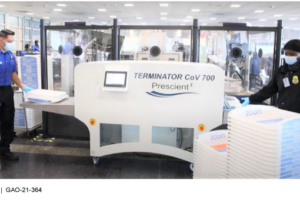TSA announces proposed rule that would require the establishment of pipeline and railroad cyber risk management programs
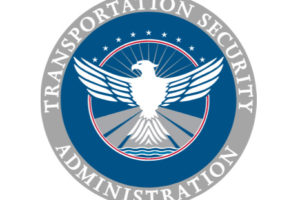



The Transportation Security Administration (TSA) announced a new cybersecurity security directive regulating designated passenger and freight railroad carriers. Today’s announcement demonstrates the Biden-Harris Administration’s commitment to strengthen the cybersecurity of U.S. critical infrastructure. Building on the TSA’s work to strengthen defenses in other transportation modes, this security directive will further enhance cybersecurity preparedness and resilience for the nation’s railroad operations.
Developed with extensive input from industry stakeholders and federal partners, including the Department of Homeland Security’s Cybersecurity and Infrastructure Security Agency (CISA) and the Department of Transportation’s Federal Railroad Administration (FRA), this Enhancing Rail Cybersecurity – SD 1580/82-2022-01 strengthens cybersecurity requirements and focuses on performance-based measures to achieve critical cybersecurity outcomes.
“The nation’s railroads have a long track record of forward-looking efforts to secure their network against cyber threats and have worked hard over the past year to build additional resilience, and this directive, which is focused on performance-based measures, will further these efforts to protect critical transportation infrastructure from attack,” said TSA Administrator David Pekoske. “We are encouraged by the significant collaboration between TSA, FRA, CISA and the railroad industry in the development of this security directive.
The security directive requires that TSA-specified passenger and freight railroad carriers take action to prevent disruption and degradation to their infrastructure to achieve the following critical security outcomes:
1. Develop network segmentation policies and controls to ensure that the Operational Technology system can continue to safely operate in the event that an Information Technology system has been compromised and vice versa;
2. Create access control measures to secure and prevent unauthorized access to critical cyber systems;
3. Build continuous monitoring and detection policies and procedures to detect cybersecurity threats and correct anomalies that affect critical cyber system operations; and
4. Reduce the risk of exploitation of unpatched systems through the application of security patches and updates for operating systems, applications, drivers, and firmware on critical cyber systems in a timely manner using a risk-based methodology.
Passenger and freight railroad carriers are required to:
1. Establish and execute a TSA-approved Cybersecurity Implementation Plan that describes the specific cybersecurity measures the passenger and freight rail carriers are utilizing to achieve the security outcomes set forth in the security directive.
2. Establish a Cybersecurity Assessment Program to proactively test and regularly audit the effectiveness of cybersecurity measures and identify and resolve vulnerabilities within devices, networks, and systems.
This is the latest in TSA’s performance-based security directives; previous security directives include requirements such as reporting significant cybersecurity incidents to CISA, establishing a cybersecurity point of contact, developing and adopting a cybersecurity incident response plan, and completing a cybersecurity vulnerability assessment. Through this security directive, TSA continues to take steps to protect transportation infrastructure in the current threat environment. TSA also intends to begin a rulemaking process, which would establish regulatory requirements for the rail sector following a public comment period.
To view TSA’s security directives and guidance documents, please visit the TSA cybersecurity toolkit.

The Transportation Security Administration (TSA) announced the revision and reissuance of its Security Directive regarding oil and natural gas pipeline cybersecurity. This revised directive will continue the effort to build cybersecurity resiliency for the nation’s critical pipelines.
Developed with extensive input from industry stakeholders and federal partners, including the Department’s Cybersecurity and Infrastructure Security Agency (CISA), the reissued security directive for critical pipeline companies follows the directive announced in July 2021. The directive extends cybersecurity requirements for another year, and focuses on performance-based – rather than prescriptive – measures to achieve critical cybersecurity outcomes.
“TSA is committed to keeping the nation’s transportation systems safe from cyberattacks. This revised security directive follows significant collaboration between TSA and the oil and natural gas pipeline industry. The directive establishes a new model that accommodates variance in systems and operations to meet our security requirements,” said TSA Administrator David Pekoske. “We recognize that every company is different, and we have developed an approach that accommodates that fact, supported by continuous monitoring and auditing to assess achievement of the needed cybersecurity outcomes. We will continue working with our partners in the transportation sector to increase cybersecurity resilience throughout the system and acknowledge the significant work over the past year to protect this critical infrastructure.”
Following the May 2021 ransomware attack on a major pipeline, TSA issued several security directives mandating that critical pipeline owners and operators implement several urgently needed cybersecurity measures. In the fourteen months since this attack, the threat posed to this sector has evolved and intensified. Reducing this national security risk requires significant public and private collaboration.
Through this revised and reissued security directive, TSA continues to take steps that protect transportation infrastructure from evolving cybersecurity threats. TSA also intends to begin the formal rulemaking process, which will provide the opportunity for the submission and consideration of public comments.
The reissued security directive takes an innovative, performance-based approach to enhancing security, allowing industry to leverage new technologies and be more adaptive to changing environments. The security directive requires that TSA-specified owners and operators of pipeline and liquefied natural gas facilities take action to prevent disruption and degradation to their infrastructure to achieve the following security outcomes:
- Develop network segmentation policies and controls to ensure that the Operational Technology system can continue to safely operate in the event that an Information Technology system has been compromised and vice versa;
- Create access control measures to secure and prevent unauthorized access to critical cyber systems;
- Build continuous monitoring and detection policies and procedures to detect cybersecurity threats and correct anomalies that affect critical cyber system operations; and
- Reduce the risk of exploitation of unpatched systems through the application of security patches and updates for operating systems, applications, drivers and firmware on critical cyber systems in a timely manner using a risk-based methodology.
Pipeline owners and operators are required to:
- Establish and execute a TSA-approved Cybersecurity Implementation Plan that describes the specific cybersecurity measures the pipeline owners and operators are utilizing to achieve the security outcomes set forth in the security directive.
- Develop and maintain a Cybersecurity Incident Response Plan that includes measures the pipeline owners and operators will take in the event of operational disruption or significant business degradation caused by a cybersecurity incident.
- Establish a Cybersecurity Assessment Program to proactively test and regularly audit the effectiveness of cybersecurity measures and identify and resolve vulnerabilities within devices, networks, and systems.
These requirements are in addition to the previously established requirement to report significant cybersecurity incidents to CISA, establish a cybersecurity point of contact and conduct an annual cybersecurity vulnerability assessment.

As a key part of the EU's work to build a Security Union, the new rules will strengthen the resilience of critical infrastructure to a range of threats, including natural hazards, terrorist attacks, insider threats, or sabotage, as well as public health emergencies like the recent COVID-19 pandemic.
Against an ever more complex risk landscape, the new Directive replaces the European Critical Infrastructure Directive of 2008. A wider sectoral scope will allow Member States and critical entities to better address interdependencies and potential cascading effects of an incident. Eleven sectors will be covered: energy, transport, banking, financial market infrastructures, health, drinking water, wastewater, digital infrastructure, public administration, space, and food.
Vice-President for Promoting our European Way of Life, Margaritis Schinas, said: “It is essential to shield our economy and our society against physical threats that could disrupt services that are vital for people's daily lives and for the functioning of our internal market. With today's agreement, we are delivering on our commitment to enhance the resilience of critical infrastructure in the EU, complementing the recently strengthened cybersecurity legislation. Together, these new rules form a coherent and robust system to protect our infrastructure online and off”.
Commissioner for Home Affairs, Ylva Johansson, said: “In the light of the current geopolitical situation in Europe, enhancing our resilience is of key importance. The CER Directive will make us better prepared against disruptions that impact the security of our citizens and the prosperity of the internal market, following the lessons learnt from the pandemic and long-term challenges like climate change. The new Directive will ensure the provision of essential services such as energy, transport, water and healthcare while minimising the impact of natural and man-made incidents”.
The proposal introduces new rules to strengthen the resilience of critical entities:
- Member States will need to adopt a national strategy and carry out regular risk assessments to identify entities that are considered critical or vital for the society and the economy.
- Critical entities will need to carry out risk assessments of their own, take technical and organisational measures to enhance their resilience and notify incidents. They will also be able to request background checks on personnel holding sensitive roles.
- Critical entities in the EU, from the sectors covered, providing essential services in six Member States or more, will benefit from extra advice on how best to meet their obligations to assess risks and take resilience-enhancing measures.
- A Critical Entities Resilience Group will facilitate cooperation among Member States and the exchange of information and good practices.
- An enforcement mechanism will help ensure that the rules are followed: Member States will need to ensure that national authorities have the powers and means to conduct on-site inspections of critical entities. Member States will also introduce penalties in case of non-compliance.
- Member States will need to provide support to critical entities in enhancing their resilience with, for instance, guidance material. The Commission will provide complementary support to Member States and critical entities, by developing a Union-level overview of cross-border and cross-sectoral risks, best practices, methodologies, cross-border training activities and exercises to test the resilience of critical entities, among others.
Next steps
The political agreement reached by the European Parliament and the Council is now subject to formal approval by the co-legislators. Once published in the Official Journal, the Directive will enter into force 20 days after publication. Member States will then need to transpose the elements of the Directive into national law within 21 months.

The European Union Agency for Cybersecurity (ENISA) delivers a joint report with the European Rail Information Sharing and Analysis Center (ISAC) to support the sectorial implementation of the NIS Directive.
The report released is designed to give guidance on building cybersecurity zones and conduits for a railway system.
The approach taken is based on the recently published CENELEC Technical Specification 50701 and is complemented with a guidance to help railway operators with the practical implementation of the zoning process.
The work gathers the experience of the European Rail ISAC and of their members such as European infrastructure managers and railway undertakings, which are Operators of Essential Services (OES) as defined in the Security of Network and Information Systems (NIS) directive and is designed to help them implement the cybersecurity measures needed in the zoning and conduits processes.
A number of requirements are set, such as:
- Identification of all assets and of basic process demands;
- Identification of global corporate risks;
- Performing zoning;
- Checking threats.
A risk assessment process is developed based on standards for the identification of assets and the system considered, and for the partitioning of zones and conduits. The report also addresses the cybersecurity requirements in terms of documentation and suggests a step-by-step approach to follow.
The report is released on the occasion of the General Assembly meeting of the European Rail ISAC which is taking place today.
The EU Agency for Cybersecurity engages closely with the European Rail Agency (ERA) to support the railway sector and is to host a joint event with ERA later this year.
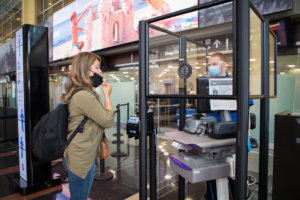
There are a handful of actions that travelers can take in an effort to get through Transportation Security Administration (TSA) airport checkpoints during the pandemic in ways that may help reduce the likelihood of contracting COVID-19.
While security is TSA’s top priority, the health and safety of TSA employees and the traveling public is of utmost importance. TSA remains in close communication with medical professionals, the CDC, and various government agencies as we continue to carry out its security mission during the pandemic.
Here are a few suggestions that TSA Federal Security Directors want to share with travelers who are scheduled to fly during the pandemic.
- John Bambury, TSA Federal Security Director for John F. Kennedy International Airport: “You’ve heard it a thousand times—wear a mask. I wear a mask every single day at the airport, which is one of the top recommendations from the CDC. If you’re flying, you should also consider carrying an extra mask so that if the elastic band snaps on your mask, you’ve got a spare one handy. Also, you may want to change into a fresh mask upon arrival at your destination. If you don’t have a mask, the TSA officer at the travel document checking podium will offer you one for free. When you get to the travel document podium, the TSA officer will ask you to remove your mask for just a few seconds to verify that your face matches the ID that you are presenting.”
- Scott T. Johnson, TSA Federal Security Director for Washington Dulles International and Ronald Reagan Washington National Airports: “Consider enrolling in TSA PreCheck® because it gets you through the checkpoint conveniently and more quickly than a standard checkpoint lane, making it even more valuable in today’s travel climate. TSA PreCheck passengers spend less time waiting in line and keep their shoes, belts and jackets on during screening and electronics in their carry-ons, reducing overall contact during screening. Travelers in the program also are permitted to leave their 3-1-1 liquids bag in their carry-on bags.”
- Gerardo Spero, TSA Federal Security Director for Philadelphia International Airport: “Know before you go. By that I mean that you need to know what is in your carry-on bag before you head to the airport to ensure that you have nothing prohibited with you. Prohibited items such as large liquids, knives, pepper spray, loose ammunition, and other prohibited items result in our need to open your carry-on bag and remove them. This keeps you in the checkpoint for an extra few minutes while one of our TSA officers opens your carry-on to search and eventually remove the item. We want to get you through the security checkpoint efficiently and quickly. Prohibited items slow you down.”
- Thomas Carter, TSA Federal Security Director for Newark Liberty International Airport: “The CDC recommends washing your hands frequently. Consider washing your hands before and after completing the security screening process. If it is not possible to wash your hands, please use hand sanitizer. TSA has instituted a temporary exemption from the 3-1-1 rule, that permits travelers to carry up to one 12-ounce container of liquid hand sanitizer per passenger, in carry-on bags. You can also bring individual hand wipes or a large tub of hand wipes with you to help wipe down your hands and even handles of your carry-on bags.”
- John C. Allen, TSA Federal Security Director for Yeager Airport: “Do your best to socially distance from others whenever possible. By that I mean, leave some extra space between the traveler in line ahead of you. Take that an extra step back. After you go through the checkpoint scanner, that’s another opportunity to take an extra step back while you wait for your carry-on items along the conveyor belt. Look around, see where you can wait for your carry-on items a little farther away from fellow passengers. Then take your belongings off to the side to put on your shoes, jacket and other items so that you’ve got some extra space of your own to recompose.”
- Grant Goodlett, TSA Federal Security director for Baltimore/Washington International-Thurgood Marshall Airport: “If you haven’t traveled in a while, you will notice that TSA has installed acrylic shields in checkpoints in an effort to make the screening process safer for passengers and our workforce by reducing the potential of exposure to the coronavirus. Please don’t walk around these acrylic shields to interact with our TSA officers. The shields have small vents to allow for conversation, questions and answers to be shared.”
[Source: TSA]
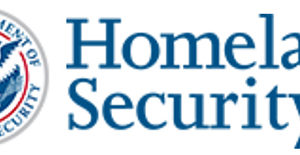
DHS’s Transportation Security Administration (TSA) has announced two new Security Directives and additional guidance for voluntary measures to strengthen cybersecurity across the transportation sector in response to the ongoing cybersecurity threat to surface transportation systems and associated infrastructure. These actions are among several steps DHS is taking to increase the cybersecurity of U.S. critical infrastructure.
“These new cybersecurity requirements and recommendations will help keep the traveling public safe and protect our critical infrastructure from evolving threats,” said Secretary of Homeland Security Alejandro N. Mayorkas. “DHS will continue working with our partners across every level of government and in the private sector to increase the resilience of our critical infrastructure nationwide.”
TSA is increasing the cybersecurity of the transportation sector through Security Directives, appropriately tailored regulations, and voluntary engagement with key stakeholders. In developing its approach, including these new Security Directives, TSA sought input from industry stakeholders and federal partners, including the Department’s Cybersecurity and Infrastructure Security Agency (CISA), which provided expert guidance on cybersecurity threats to the transportation network and countermeasures to defend against them.
The TSA Security Directives announced today target higher-risk freight railroads, passenger rail, and rail transit, based on a determination that these requirements need to be issued immediately to protect transportation security. These Directives require owners and operators to:
- designate a cybersecurity coordinator;
- report cybersecurity incidents to CISA within 24 hours;
- develop and implement a cybersecurity incident response plan to reduce the risk of an operational disruption; and,
- complete a cybersecurity vulnerability assessment to identify potential gaps or vulnerabilities in their systems.
TSA is also releasing guidance recommending that all other lower-risk surface transportation owners and operators voluntarily implement the same measures. Further, TSA recently updated its aviation security programs to require that airport and airline operators implement the first two provisions above. TSA intends to expand the requirements for the aviation sector and issue guidance to smaller operators. TSA also expects to initiate a rule-making process for certain surface transportation entities to increase their cybersecurity resiliency.
These efforts are part of a series of new steps to prioritize cybersecurity across DHS. Secretary Mayorkas first outlined his vision for the Department’s cybersecurity priorities in March, which included a series of focused 60-day sprints designed to elevate existing work, remove roadblocks to progress, and launch new initiatives and partnerships to achieve DHS’s cybersecurity mission and implement Biden-Harris Administration priorities. To learn more about the sprints, please visit www.dhs.gov/cybersecurity.
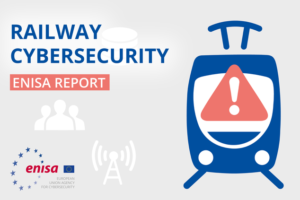
European railway undertakings (RUs) and infrastructure managers (IMs) need to address cyber risks in a systematic way as part of their risk management processes. This need has become even more urgent since the Network and Information Security (NIS) Directive came into force in 2016.
Objectives of the Railway Cybersecurity report
The purpose of the report is to provide European RUs and IMs with applicable methods and practical examples on how to assess and mitigate cyber risks.
The good practices presented are based on feedback from railway stakeholders. They include tools, such as assets and services list, cyber threat scenarios and applicable cybersecurity measures, based on the standards and good practices used in the sector. These resources can be used as a basis for cyber risk management for railway companies. They are therefore intended to be a reference point and to promote collaboration between railway stakeholders across the EU while raising awareness on relevant threats.
The main takeaways
For the risk management of railway Information Technology (IT) systems, the most cited approaches were the requirements of NIS Directive at a national level, the ISO 2700x family of standards, and the NIST cybersecurity framework.
For Operational Technology (OT) systems, the frameworks cited were ISA/IEC 62443, CLC/TS 50701, and the recommendations of the Shift2Rail project X2Rail-3, or the ones from the CYRail Project.
Those standards or approaches are often used in a complementary way to adequately address both IT and OT systems. While IT systems are normally evaluated with broader and more generic methods (such as ISO 2700x or NIS Directive), OT systems need specific methods and frameworks that have been designed for industrial train systems.
There is no unified approach available to railway cyber risk management yet. Stakeholders who participated in this study indicated that they use a combination of the abovementioned international and European approaches to tackle risk management, which they then complement with national frameworks and methodologies.
For RUs and IMs to manage cyber risks, identifying what needs protection is essential. In this report, a comprehensive list is broken down to 5 areas; the services that stakeholders provide, the devices (technological systems) that support these services, the physical equipment used to provide these services, the people that maintain or use them, and the data used.
RUs and IMs need to identify which cyber threats are applicable to their assets and services. The report reviews available threat taxonomies, and provides a list of threats that can be used as the basis.
Examples of cyber risk scenarios are also analysed, which can assist railway stakeholders when performing a risk analysis. They show how asset and threat taxonomies can be used together and are based on the known incidents of the sector and the feedback received during the workshops.
Each scenario is associated with a list of relevant security measures. The report includes cybersecurity measures derived from the NIS Directive, current standards (ISO/IEC 27002, IEC 62443) and good practises (NIST’s cybersecurity framework).
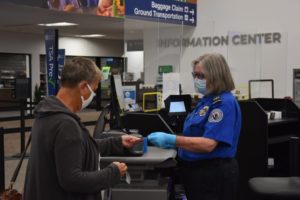
A credential authentication technology (CAT) unit has been installed and is in use at the Transportation Security Administration checkpoint at Capital Region International Airport (LAN).
“The new credential authentication technology unit enhances our detection capabilities for identifying fraudulent ID documents and improves the passenger’s experience by increasing efficiency during the checkpoint experience,” said Michigan TSA Federal Security Director Steve Lorincz. “The CAT unit also reduces touchpoints at the checkpoint, which benefits both officers and travelers during this pandemic.”
Passengers will approach the travel document checking station at the checkpoint and listen to the instructions of the TSA officer, who will insert the personal identification into the scanner for authentication.
Passengers will not have to hand over their boarding pass (electronic or paper), thus reducing a touchpoint. Instead, they should have their boarding pass ready in the event that the TSA officer requests visual inspection. The CAT unit will verify that the traveler is prescreened to travel out of the airport for a flight that day; however, a boarding pass may be requested for travelers under the age of 18 and/or those without IDs or with damaged IDs.
“We are pleased that TSA is taking steps to enhance the technology to ensure the safety and security of our travelers here at the Capital Region International Airport (LAN),” said Nicole Noll-Williams, president and CEO of the Capital Region Airport Authority.
Even with TSA’s use of CAT, travelers still need to check-in with their airline in advance and bring their boarding pass to their gate agent to show the airline representative before boarding their flight.
This technology will enhance detection capabilities for identifying fraudulent documents at the security checkpoint. CAT units authenticate several thousand types of IDs including passports, military common access cards, retired military ID cards, Department of Homeland Security Trusted Traveler ID cards, uniformed services ID cards, permanent resident cards, U.S. visas, and driver’s licenses and photo IDs issued by state motor vehicle departments.
